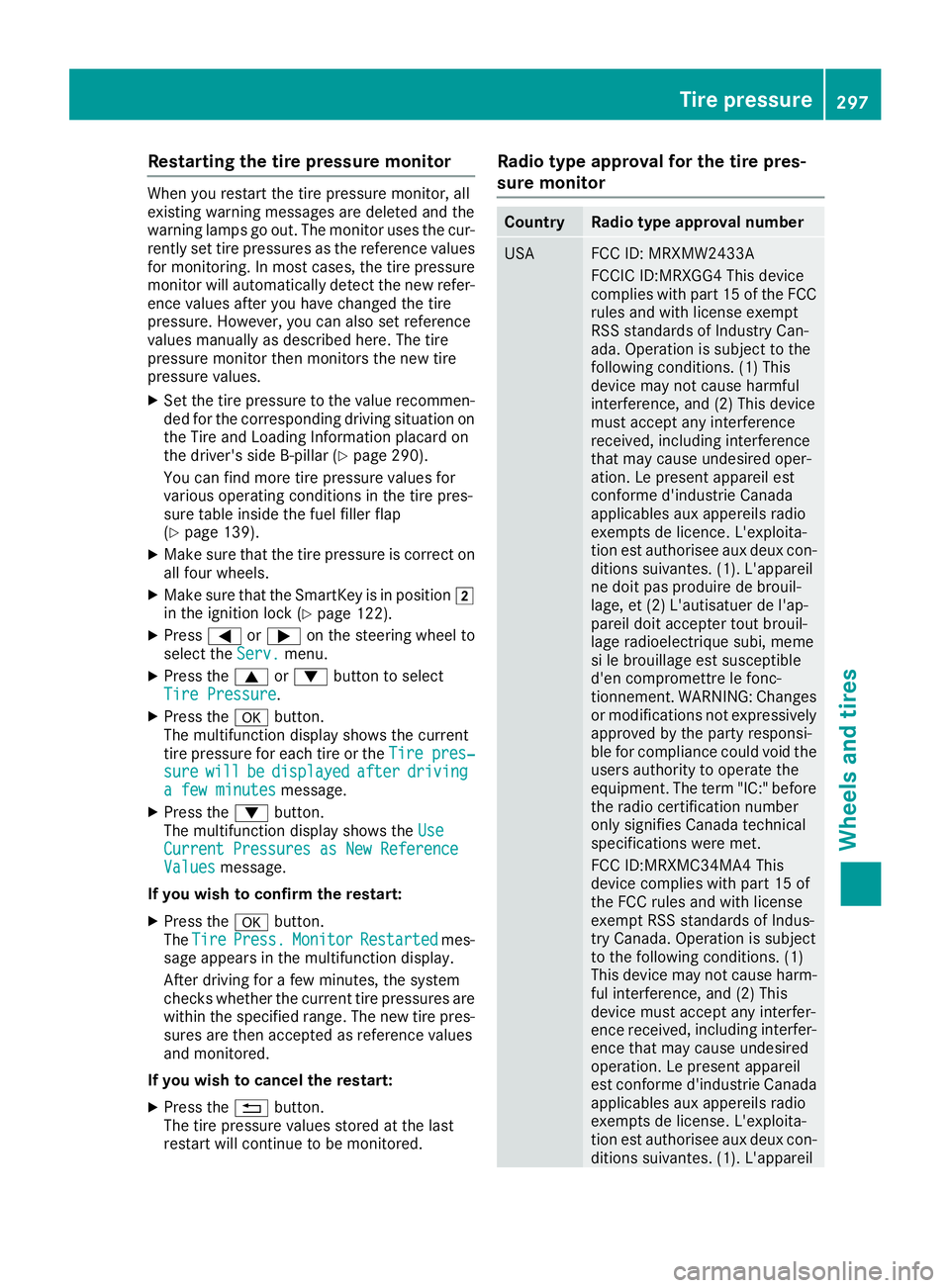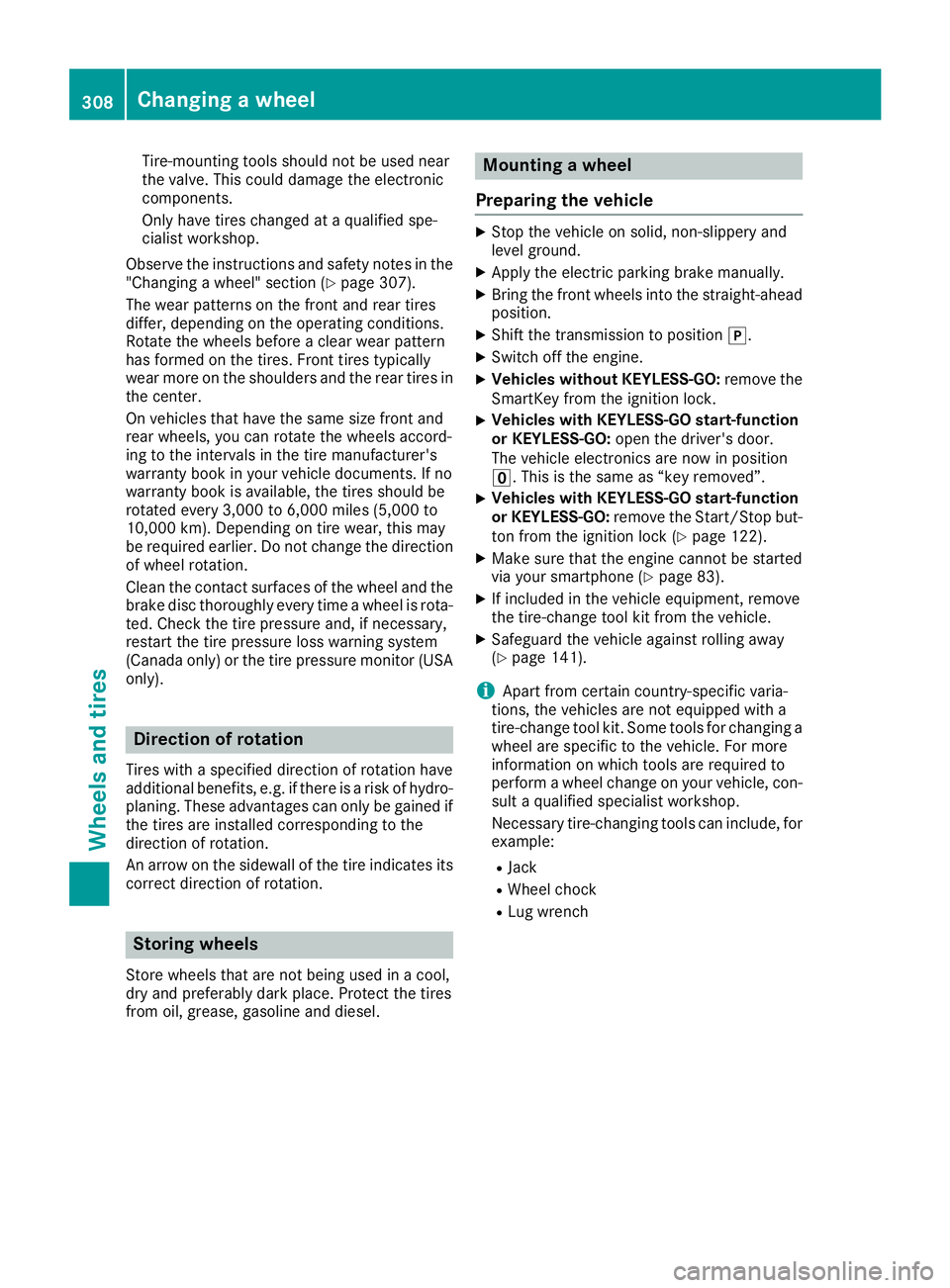2018 MERCEDES-BENZ CLA ignition
[x] Cancel search: ignitionPage 299 of 326

Restarting the tire pressure monitor Whe ny ou restart the tire pressure monitor, all
existing warning messages are deleted and the
warning lamps go out. The monitor uses the cur-
rentl ys et tire pressures as the reference values
for monitoring. In most cases, the tire pressure
monitor will automaticall yd etect the new refer-
ence value sa fte ry ou have changed the tire
pressure. However, yo uc an also set reference
value sm anually as described here. The tire
pressure monitor then monitors the new tire
pressure values. X
Set the tire pressure to the value recommen-
ded for the corresponding driving situation on
the Tire and Loading Information placard on
the driver' ss id eB -pillar ( Y
page 290).
Yo uc an find more tire pressure value sf or
various operating conditions in the tire pres-
sure table inside the fue lf ille rf lap
( Y
page 139). X
Make sure that the tire pressure is correct on
al lf ou rw he els.X
Make sure that the SmartKey is in position �H
in the ignition lock ( Y
page 122).X
Press �Y or �e on the steering wheel to
select the Serv. menu.X
Press the �c or �d button to select
Tire Pressure .X
Press the �v button.
The multifunction display shows the current
tire pressure for each tire or the Tire pres‐
sure will be displayed after driving
af ew minutes message.X
Press the �d button.
The multifunction display shows the Use
Current Pressure sasN ew Reference
Values message.
If you wish to confirm the restart: X
Press the �v button.
The Tire Press. Monitor Restarted mes-
sage appears in the multifunction display.
After driving for af ew minutes, the system
checks whethe rt he current tire pressures are
within the specified range. The new tire pres-
sures are then accepted as reference values
and monitored.
If you wish to cance lt he restart:X
Press the �8 button.
The tire pressure value ss tore datt he last
restart will continu etobem onitored. Radio type approval for the tire pres-
sure monitor Country Radio type approval number
USA FCC ID: MRXMW2433A
FCCIC ID:MRXGG4 Thi sd evice
complies with part 15 of the FCC
rules and with license exempt
RSS standard sofI ndustry Can-
ada. Operation is subject to the
following conditions .( 1) This
device may not cause harmful
interference, and (2) Thi sd evice
mus ta ccept any interference
received, including interference
that may cause undesired oper-
ation. Le present apparei le st
conforme d'industri eC an ada
applicables au xa pp ereils radio
exempts de licence. L'exploita-
tion est authorisee au xd eu xc on-
ditions suivantes. (1) .L 'appareil
ne doi tp as produire de brouil-
lage, et (2) L'autisatue rdel 'ap-
parei ld oi ta ccepter tou tb rouil-
lage radioelectriqu es ubi, meme
si le brouillag ee st susceptible
d'e nc ompromettre le fonc-
tionnement. WARNING :C ha nges
or modifications not expressively
approved by the party responsi-
bl ef or compliance could voi dt he
users authority to operate the
equipment. The term "IC:" before
the radio certification number
only signifies Canad at echnical
specifications were met.
FCC ID:MRXMC34MA4 This
device complies with part 15 of
the FCC rules and with license
exempt RSS standard sofI ndus-
try Canada. Operation is subject
to the following conditions .( 1)
Thi sd evice may not cause harm-
ful interference, and (2) This
device mus ta ccept any interfer-
ence receive d, i ncluding interfer-
e nce that may cause undesired
operation. Le present appareil
est conforme d'industri eC an ada
applicables au xa pp ereils radio
exempts de license .L 'exploita-
tion est authorisee au xd eu xc on-
ditions suivantes. (1) .L 'appareilTire pressure 297
Wheel sa nd tires Z
Page 310 of 326

Tire-mounting tools should not be used near
the valve. This could damage the electronic
components.
Only have tires changed at aq ualified spe-
cialist workshop.
Observe the instructions and safety notes in the
"Changing aw heel" section ( Y
page 307).
The wear pattern sont he front and rear tires
differ, depending on the operating conditions.
Rotate the wheels before ac lear wear pattern
has formed on the tires. Fron tt ires typically
wear more on the shoulders and the rear tires in
the center.
On vehicles that have the same size front and
rear wheels, you can rotat et he wheels accord-
ing to the intervals in the tire manufacturer's
warranty book in your vehicle documents. If no
warranty book is available, the tires should be
rotated every 3,000 to 6,000 miles (5,000 to
10,00 0k m) .D ependin gont ire wear, this may
be required earlier. Do not change the direction
of wheel rotation.
Clean the contact surfaces of the wheel and the
brake disc thoroughly every time aw heel is rota-
ted. Check the tire pressure and, if necessary,
restart the tire pressure loss warning system
(Canada only) or the tire pressure monitor (USA
only).
Direction of rotation Tires with as pecified direction of rotation have
additional benefits ,e .g. if there is ar isk of hydro-
planing. These advantages can only be gained if
the tires are installed corresponding to the
direction of rotation.
An arrow on the sidewall of the tire indicates its
correc td irection of rotation.
Storing wheels Stor ew heels that are not being used in ac ool,
dry and preferably dark place. Protec tt he tires
from oil, grease, gasoline and diesel. Mounting aw heel
Preparing the vehicle X
Stop the vehicle on solid, non-slippery and
level ground. X
Apply the electric parking brake manually. X
Bring the front wheels into the straight-ahead
position. X
Shift the transmission to position �] .X
Switch off the engine. X
Vehicles without KEYLESS-GO: remove the
SmartKey from the ignition lock. X
Vehicles with KEYLESS-GO start-function
or KEYLESS-GO: open the driver's door.
The vehicle electronics are now in position
�
Page 318 of 326

Other identifications, for example: R
0W -30R
5W -30R
5W -40
Fuel
Important safety notes
G WARNING
Fuel is highly flammable. If you handle fuel
incorrectly, there is ar isk of fire and explo-
sion.
You must avoid fire, open flames, creating
sparks and smoking. Switch off the engine
and, if applicable, the auxiliary heating before
refueling.
G WARNING
Fuel is poisonous and hazardous to health.
There is ar isk of injury.
You must make sure that fuel does not come
into contact with your skin, eyes or clothing
and that it is not swallowed. Do not inhale fuel
vapors. Keep fuel awa yf rom children.
If you or others come into contact with fuel,
observe the following: R
Wash awa yf uel from skin immediately
using soap and water. R
If fuel comes into contact with your eyes,
immediately rinse them thoroughly with
clean water. Seek medical assistance with-
out delay. R
If fuel is swallowed, seek medical assis-
tance without delay .Don ot induce vomit-
ing. R
Immediately change out of clothing which
has come into contact with fuel. Tank capacity Model Total capa-
city
CLA 250
13.2 US gal
(50.0 l)
Al lo th er models
14.8 US gal
(56.0 l)
Model Of which
reserve
Mercedes ‑ AM Gv ehicles
Approx.
2.1 US gal
(8.0 l)
All other models
Approx.
1.6 US gal
(6.0 l)
Gasoline
Fuel grade
! Do not use diesel to refue lv ehicles with a
gasoline engine. Do not switch on the ignition
if you accidentally refue lw ith the wrong fuel.
Otherwise, the fuel wil le nter the fuel system.
Even smal la mounts of the wrong fuel could
resul tind amage to the fuel system and the
engine. Notify aq ualified specialist workshop
and have the fuel tank and fuel lines drained
completely.
! Only refue lu sing unleaded premium grade
gasoline with at least 91 AKI/95 RON.
i E10 fuel contains up to 10% bioethanol.
You rv ehicl eisE 10-compatible. You can
refue ly ou rv ehicl eu sing E10 fuel.
! Only use the fuel recommended. Operating
the vehicl ew ith other fuel sc an lea dtod am-
age to the fuel system, engine and exhaust
system.
! Do not use the following: R
Gasoline with more than 10% ethanol R
E100 (1 00% ethanol) R
Gasoline with methanol R
M100 (1 00% methanol) R
Gasoline with metalliferous additives R
Diesel316
Service products and fillin gc apacities
Technical data